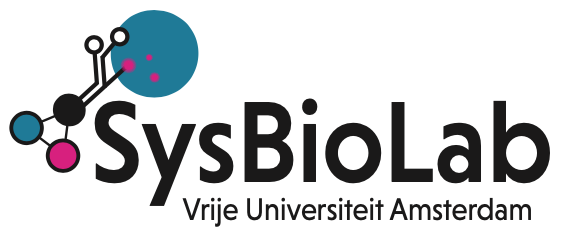Modelling WorkGroup – Teaching Sessions
The notes of the teaching session can be found in this Overleaf file.
Additional topics for discussion:
– bistability
– origins of division of labour in microbial communities (incl. overflow metabolism)
Schedule for the Friday Modelling Teaching meetings
Session I
Aim: to obtain a basic understanding of macroscopic features of a population of cells at balanced growth
Topics:
– Cell size, cellular organization, diffusion speeds, macromolecular composition,
– Balanced growth, generation time, specific growth rate, specific nutrient uptake rates, basic calculations, growth media
– Macromolecular equation and yields
– Steady-state metabolism at balanced growth, dilution by growth
– 1/V dn/dt as the metabolism component of dc/dt
– Cultivation methods for balanced growth
Session II/III
Aim: To understand that:
i. during balanced growth, cellular macromolecules (DNA, RNA, membranes, proteins) are made from precursors (nucleic acids, lipids, amino acids), which are in turn made from nutrients available in the growth medium, in “anabolism”.
ii. Anabolism is a Gibbs free energy demanding process, which is driven (made possible) by catabolism.
iii. Catabolism is the conversion of the energy source (one, or more, of the nutrients in the growth medium) into products during which Gibbs free energy is liberated, in the form of energy equivalents, driving anabolism.
iv. Only at thermodynamic equilibrium is the energy transfer from catabolism to anabolism occurring at 100% efficiency, then no energy is wasted.
v. Thermodynamic efficiency is, however, not the case during growth, which is a non-equilibrium process, then more energy source is needed the equilibrium amount. So, the biomass yield on the energy source increases when the efficiency of energy transfer is lower.
vi. The rate-yield trade off concerns the “urban legend” that high specific growth rates are accompanied by low biomass yields on substrate (energy source). We will discuss this issue.
Topics:
– Internal energy of a system can change via heat and work exchange
– Derivation of the Gibbs free energy of a system from the internal energy of the system, understanding of the second law of thermodynamics in terms of the Gibbs free energy.
– Gibbs free energy of reactions, linear metabolic pathways, energy dissipation in non-equilibrium states and submaximal thermodynamic efficiencies
– Gibbs free energy requirement for the synthesis of ATP
– Relate the biomass yield on the energy substrate to the Gibbs free energies of catabolism and anabolism, relate to thermodynamic efficiency, calculate maximal yield on the basis of 100% efficiency, more than energy is needed for synthesis of ATP than what can be liberated from it non-equilibrium states
– Consider the situation in a chemostat when the growth rate is increased but the yield is held, so the same EFM is used, then the limiting substrate concentration goes up and the product concentrations remain the same, thus the thermodynamic driving force over the cell increases and the saturations of enzymes can now increases. The biomass yield increases, what happens to the thermodynamic efficiency?
– Discussion of the rate-yield trade off
Session IV/V
Aim: obtain a basic understanding of mass-action and enzyme kinetics.
Topics:
– Mass-action kinetics
– Mass-action kinetics descriptions of enzyme mechanisms
– Quasi-equilibrium and quasi-steady state enzyme kinetics derivations
– Relation enzyme rate and thermodynamic driving force (Gibbs free energy potential)
– Relationship between Gibbs free energy potential and substrate saturation of enzymes
– Maximization of specific flux of metabolic pathways (flux maximization under fixed total available enzyme) by optimal allocation of enzymes at fixed Gibbs free energy potential of the pathway, relationship between Gibbs free energy potential, mean substrate saturation and enzyme requirement.
– Discussion of division of labour in microbial communities, e.g. hydrogen exchange.
Session VI
Aim: obtain an understanding of stoichiometric modelling of metabolic networks
Topics:
– N, K, L matrices
– Nullspace
– Elementary flux modes
– Constrained optimization of fluxes (FBA), EFMs as optimal solutions
Session VII
Aim: to obtain an understanding of dynamic models of metabolic networks using enzyme kinetics
Topics:
– dx/dt = Nv
– Jacobian matrix and stability
– Glycolysis model, stoichiometric analysis
– Glycolysis model, equilibrium block and elimination of equilibrium reactions
– Dynamics of glycolysis model
Session VIII
Aim: optimization of the specific flux of dynamic models of metabolic pathways
Topics:
– Constrained optimization and the flux control coefficient equals the relative enzyme investment
– Numerical examples
– EFM maximizes specific flux of a dynamic model of a general network
Session IX
Aim: understand metabolic control analysis and regulatory principles of metabolism
Topics:
– Introduction of MCA with two enzyme system
– Branched system
– Moiety conserved system
– Negative feedback, homeostasis and control by demand
– Flux control by equilibrium enzymes
– Thermodynamics, elasticity coefficients and control
– Hierarchical control and the central dogma of molecular biology
Session X
Aim: understand the growth rate of a cell in terms of averages properties of metabolism
Topics:
– Perform the derivation and analyze equation
– Analysis influence of non-growth associated protein expression
– Recognize the driving force of the entire system
– Evolutionary maximization of growth rate and division of labour as a byproduct
– Monod equation derivation
– Two-species model of syntrophic interactions

Recent Comments